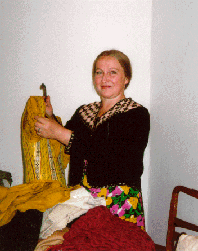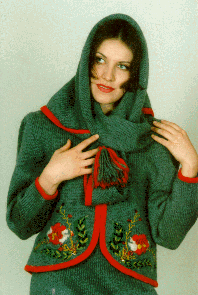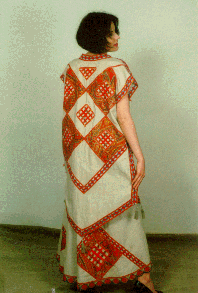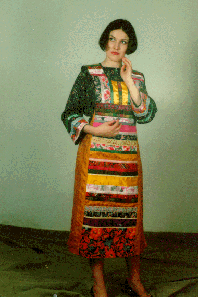

|
I Cannot Think of Myself
without "Slavyanka"
|
|
|
Slavyanka Center of Women’s Art has been operating for over five
years now. For a small manufacturer of women’s clothes the term seems long
enough. Scores of like ventures emerged at dawn of so-called co-operative
era, and most of them passed out within a year or two under pressures of
competitive market. And Slavyanka is one of the few that has survived and
keep on operating. However, Lyudmila Vladimirovna Andriyenko, the owner
of the Women’s Art Center has to admit that "every particular year
for us is a year of tough fighting for survival, just as for a soldier
at wartime every day is.
" Lyudmila Vladimirovna is a woman of typical Slav style: light
brown hair, blue eyes, shapely body, she is all radiance and softness...
Yet from times beyond recall this seeming softness and pliability of Slav
women was but cover for their inborn energy, persistence, and power — and
not of oppressive kind, but rather of transforming and attractive origin.
And the first close look at Lyudmila Andriyenko immediately reveals that
power in her. But most of all, she wins over you with her vigorous and
affectionate manner of speaking of her doings and loving attitude towards
things that constitute the cause of her life today.
|
 |
‘Speak of yourself, please,’ I asked her, and the first thing Lyudmila
Vladimirovna said was, ‘Slavyanka Center—’ ‘On no,’ I said, ‘I want to
learn something about you first.’ And she said, ‘I cannot think of myself
without Slavyanka.’
From my early days, as long as I remember myself,
I always liked needlework. And my other obsession was writing. That’s why
I decided then that when I grew up I’d be either an apparel designer or
a journalist. Well, as you see, I am not a journalist after all, though
I studied the trade at the University and that was to satisfy one of my
childhood’s ambitions. And then, through Slavyanka, it was the turn of
handiwork to take the major place in my life.
Q. In late 80s and early 90s, everyone seemed to be crazy about
starting business of their own. Folks kept running around hunting for licenses
to start individual ventures and organizing co-operative enterprises. They
thought that once they had official registrations their businesses would
go upward all by themselves and rivers of cash would downpour upon them...
Did you happen to fall victim to such illusions when you began?
L.A. Back in 1991 when we formed Slavyanka, our intention
was not to make busi-ness, but rather to bring together those who love
handiwork. At that time I attended classes and learned how to make hand-made
laces with bobbins. Many other women who attended those classes liked the
idea of handiwork as their hobby, and we de-cided to make our meetings
regular... And I am very grateful to my husband: it was him who gave us
two year non-interest loan so we could get started.
Q. Is your husband a businessman?
L.A. He tried and failed. He’s a lawyer and now he has
a good practice. But when it all began, he had a company of his own, and
Slavyanka was founded as its affiliate. Then the company collapsed, and
the center became all on its own.
Q. And in what direction has it evolved since then?
L.A. The main trend was to combine creative approach
with sustainable production. Initially, every of us actually did whatever
she wanted, and any creative initiative was welcome. Unfortunately, such
practice sometimes resulted in storerooms full of unsal-able products —
indicators of creative search failures — which we had to trade off to charity
funds.
|
Q. What about your sales today?
L.A. Our products are quite specific. On the most part
we offer hand-made items, and they are not what most retailers want. That
is why we have to rely on untraditional mar-keting tools. The most effective
of them are demonstration of our collections in various shows and exhibitions
which help us win most dedicated customers. However, to meet requirements
of current wholesale market we must restructure our production lines in
such a manner as to increase the share of machine-made products and make
it cheaper on overall... Though we never considered it to be too expensive,
as most of our customers are from high-education, medium-income social
stratum. We beat mass market products in quality and diversity, and those
of haut couture market in prices. We have various designers apt to satisfy
most diverse customers’ tastes.
Q. Getting back to Slavyanka’s handicraft roots, you have to admit
that making laces with bobbins and business management require somewhat
different skills and ap-proaches. Then how do you manage management, after
all?
|
 |
L.A. You are right. These two functions are, in fact,
hardly compatible. But I believe that to manage an organization based on
creativity principles one must employ incentive rather than oppressive
tools. On the other hand, an appropriate balance must be kept in building
relations with employees, which means that any familiarity must be ex-cluded.
As far as I know, many small businesses abroad are built on the basis of
infor-mal and sometimes family-like relations between employers and employees.
And these intimate relations help minor employers keep compensations on
fairly low level as related to large companies. The latter offer better
salaries, but impose much stricter requirements on their personnel.
 |
My opinion is that any organization must live by business laws — first
and only. All in all, we live in the world that is constantly changing.
And these changes inevitably affect every aspect of corporate life: management
patterns, organizational structure, eco-nomic relations within the company...
At first, I made a serious mistake when choosing an incentive system;
it was something of the ‘socialist’ concept: I failed to make people understand
that first they had to make some input and only then expect any return
on it. As soon as I had obtained the starting loan, I established high
salaries for my workers and distributed Slavyanka’s stock shares among
them. Now it looks a silly step. Many employees expected interest rates
would be high. Later I had to make it clear that only those of stockholding
employees might count on their share in company’s profit who actually participate
in its operations and progress; and others — I mean those quitting Slavyanka
— had their stock shares annulled.
Q. How many full-staff employees do you have?
|
L.A. Our staff constantly renews and varies from one
hundred to twenty people. The peak falls at autumn, and in summertime many
women prefer to farm their country lots.
Q. What makes your company attractive for women? Is it an opportunity
to express themselves in artistic manner? Or a chance to raise family budget
working at home? Or, maybe, simply their need for communication with the
like?
L.A. All the three, I believe. For many of them we are
a kind of life-jacket. Let me ex-plain. When Slavyanka had just begun,
I mean its all-hand-made stage, women came in and out in thousands. And
everyone was grateful. Some for lessons they had learned from us. Some
for removed distresses that had come from suddenly finding them-selves
unemployed. Just one example: once we gave home to a lady on the edge of
suicide. For a long time before her husband had been working abroad under
some good contract. His family had got used to good standards of living.
And then, all of a sudden, his contract was terminated and they all had
to return to Russia to no job, no home, no anything situation... Her husband
began to drink heavily; their son and daughter turned against them because
lack of money to pay for anything... Terrible situation. Then that women
turned to us — and we gave her a job: she taught others craftsmanship.
Eventually, they managed to get through their tough times.
We have a lot of aged and lonely people among our employees. For example,
an old lady far in her eighties who knits excellently and enjoys our fellowship.
Q. Do any other female organizations support Slavyanka?
L.A. Of course! If not for women’s organizations’ support,
we’d never had these prem-ises. Moreover, they help us by networking information
about us, find new clients for us. Mir Zhenschiny (Woman’s World) magazine
helps us a lot. This world goes because many good people inhabit it, you
know. And Slavyanka lives largely because of this simple truth. If not
for these good folks around, we’d never survived...
Q. Anyway, I believe, that there are many other good reasons for
you to survive, and ‘good folks’ is not the only secret... Could you share
some others with our readers?
L.A. First of all, we keep on going because Slavyanka’s
production is of distinct quality; it helps us find and keep our niche
in the market. Unlike many other companies, we are on this side of the
fence and never engage in ‘making money by all means’. At the same time,
we never miss a new opportunity to earn, however unusual it may seem at
first. For some time, for example, we worked under very peculiar arrangement
with Perm’ factory manufacturing knitting machines. The factory shipped
us their machines on no-prepayment basis (which is unique all by itself)
and we sold these machines in package with our design products. Mark, it
was no regular wholesale/retail arrange-ment; we sold our intellectual
property with add-on machinery! On the other hand, those machines were
best of home-made product at that time, and we took on advertising and
training functions, ran special programs.
Another example is our partnership with the Moscow Oblast Employment
Center. We organized training programs for unemployed women, taught them
patchwork basics, and then hired them to work for us. Such examples are
numerous. Whenever competi-tion is hard you have to search for new ways
to earn. So we search and find, and never idle.
|
Q. Have Slavyanka ever participated in non-profit projects?
L.A. Right now we are on planning stage of such a project.
Not long ago I met a lady, she’s the director of Konstantinovo Yesenin
Memorial Museum. And recently we have come upon an idea of ‘Yesenin’s World
in Costume and Dance’ performances. Slavy-anka’s part in this project is
to design and produce dresses for actors who will play Ye-senin’s characters.
The other activity is in the framework of the Moscow Women Help Children
project supported by the Moscow Government. Professional training workshops
for orphans are planned within Mos-Textile-Prom factories structure. Slavyanka
will manage one of training facilities. By now, we have some positive experience
of co-operation with orphanages. Some time ago Karmin female organization
donated a lot of fabric shreds to one of Moscow orphan schools. As they
could not contract any cloth factory to make some patchwork for them, they
eventually turned to us on having heard that we were good at such jobs.
We designed and made pretty dresses for their girl-students and presented
it to the school on their anniversary celebration party. Since then we
co-operate on regular ba-sis. Recently we have designed new school uniform
decorated with national symbols.
|
 |
Q. It seems that all Slavyanka’s model include some elements of
national patterns — represented in clothes style, laces design, tints combination...
What is the reason for such a traditional approach?
L.A. I believe in signs. They come from our ancestors’
experience. And the same cul-tural experiences is accumulated in traditional
design of decorations, headdresses, pieces of cloths. Everything in them
has some reason beyond it — every pattern, every combination of colors...
They are reflections of human adaptation to the external and contain definite
information. I highly respect my ancestors and I believe that experience
of past generations is relevant to modern life and must be adopted.
Of course, we can and must rearrange it in creative manner. To say,
that is what Slavyanka practices: we make modern garments, but they always
have something of ancient national tradition in them. To my opinion, respect
to national traditions is pre-requisite to self-respect. I’ve already told
you about the Yesenin stage project. The point of it is that we want the
cast to be dressed in such a manner as to make it clear to everyone: Yesenin
had become what he was because he had been born in this land, and had been
living in it, and had adopted its culture.
P.S. When I came to Slavyanka Center office I was wearing pants;
and I left it in a new gown. Hanging on a rack, it did not impress me at
all. But when I started to go, Lyudmila Vladimirovna offered me to try
it on. I was no too enthusiastic about it. But as soon as I reluctantly
put it on, all my appearance suddenly changed in such a marvelous way that
I simply could not force myself to take it off. Since then I have never
regretted I made that purchase. Moreover, I highly recommend Slavyanka
to all my friends. You can contact them in Moscow: 203 80 08.
Interview by Julia Kachalova

![]()




